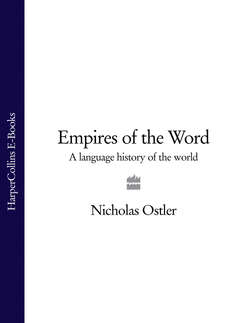Читать книгу Empires of the Word: A Language History of the World - Nicholas Ostler - Страница 36
First Unity
ОглавлениеShi Huang Di (‘First Emperor’), who had converted his rule of the Qin state§ into the first overlordship of all the known states of the Chinese world, was for many reasons a significant figure. He reigned over China for only eleven years (221–210 BC), after thirty-seven on the throne of Qin, but what years they were: besides completing the Great Wall (invaders from the north were already a problem), abolishing the power of feudal lords, carrying through an intellectual purge in a notorious rampage of book-burning, and installing the Terracotta Army in his tomb in the then capital, Chang-an, he is also famous for the standardisation of Chinese characters, as part of a general programme to introduce common laws, weights and measures. This meant imposing the local standard of his (far western) state of Qin, which happened to be one of the most conservative in use at that time. It existed in two versions, the heavily pictorial zhuànshū, ‘seal script’, still occasionally seen on ornate inscriptions and official seals, and the more cursive lìshū, ‘clerical script’. This latter was taken up under the Han empire that followed, and codified in a dictionary of the time, the Shuōwèn Jiězì of Xŭ Shèn. This system has been the basis of Chinese writing, kăishū (, ‘standard script’), ever since.
Conscious of a common language in wényán and a common script in kăishū, Chinese people took a millennium to begin to notice people diverging: early Tang literature (seventh century AD) talks of the south differing from the north in its fāng-yán, ‘regional speech’, the normal word for a dialect: this came to be a pretty strong term, also to be applied (much later14) to refer to foreign languages such as Korean, Japanese, Mongolian, Manchu and Vietnamese.
The languages spoken by China’s equestrian neighbours to its north and west were quite unrelated to the family that includes Chinese, the Sino-Tibetan languages already mentioned. Furthermore—and in this they differed from the tongues of China’s southern neighbours—they were not like Chinese typologically either. Like their modern descendants, the so-called Altaic languages* of central Asia, including the Turkic, the Mongol and the Tungus families, they are all highly polysyllabic; their words, at least the nouns and verbs, are built up systematically and agglutinatively out of strings of short elements. They are not tone languages, but they make extensive use of the principle of vowel harmony, so that the vowels in the suffixes echo the vowels of the word’s root. Their word order places the verb at the end of the sentence. In all these respects, they are radically different from Chinese, a monosyllabic tone language with little or no word formation, and a basic order in which the verb comes second in the sentence.
The Xiōngnú* were the principal steppe nomads of Mongolia and Turkestan in the third century BC. Despite their major role in Chinese history it is extremely difficult to find evidence of what their language was like. There is, however, a single quotation of ten Chinese characters, giving some advice of the Buddhist monk Fotudeng to a Xiongnu king. The characters would have been read in the fourth century AD as
syog tieg t’iei liəd kāng b’uok kuk g’iw t’uk tāng.
If we follow Louis Bazin in reading this as
süg tägti idqang, boqughigh tutqang
your army send-out, warlord hold
we can infer that their language was Turkic, rather than Mongol or Tungus.15
Three Chinese kingdoms of the north, the Qin, the Zhao and the Yan, had each built sections of wall to keep the Xiongnu out. The walls were unified and lengthened when the Qin emperor incorporated all the kingdoms into his realm. The Chinese also learnt how to oppose the Xiongnu with their own cavalry tactics. Hostilities continued for five hundred years, and for all this time the Chinese were successful in keeping the barbarians out of China, and in maintaining a forward policy that kept control throughout the western regions now known as Gansu and Qinghai; in this way, the Silk Road was secured, as well as access to the far-away horse-breeding grounds of Ferghana by the Pamirs, vital for the Chinese defence. However, their defence also depended on maintaining an active frontier garrison, and it was a costly exercise to keep the guards supplied. When the centralised government of China broke down at the end of the Han dynasty, this failed, and it became possible for the Xiongnu to penetrate the wall.
